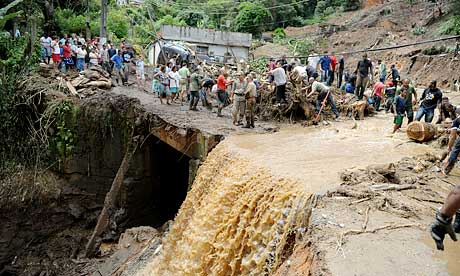When floodwaters recede, affected areas are often blanketed in silt and mud. The water and landscape can be contaminated with hazardous materials, such as sharp debris, pesticides, fuel, and untreated sewage. Potentially dangerous mold blooms can quickly overwhelm water-soaked structures. Residents of flooded areas can be left without power and clean drinking water, leading to outbreaks of deadly waterborne diseases like typhoid, hepatitis A, and cholera."
In 2011, a series of floods and mudslides took place in the Mountainous Region (Região Serrana) of Rio de Janeiro, Brazil. This disaster happened in the cities Nova Friburgo, Teresopolis, Petropolis, Sumidouro and Sao Jose do Vale do Rio Preto.
Due to the quantity of rain between the 11 and 12 January 2011 (more than expected for the entire month), the consequences were disastrous floods, mudslides and landslides.
However, many described it as being more man-made than natural. This was because of poor development decisions, such as building on insecure ground. In addition to this, a lack of disaster planning was also a factor.
The governmente response came when president Dilma Rousseff declared an emergency budget of R$ 780 million (US$ 466.2 million) to be made available for reconstruction work, such as federal assistance in machinery, helicopters and manpower, as requested by the governor Luis Fernando Pezao.
The obvious consequences of this major disaster in Brazil were the loss of 905 people and the 35 thousand who became homeless, according to Civil Defense authorities. Power and telephone lines were down in the three towns, and there was no drinking water. There was also a serious impact on industry, agriculture, livestock, trade, tourism and service providers.
Also, cases of leptospirosis* were reported in Nova Friburgo and Teresopolis.
This was the worst weather-related disaster in Brazil's history.
Photos:




Bibliographical references:
http://environment.nationalgeographic.com/environment/natural-disasters/floods-profile
No comments:
Post a Comment